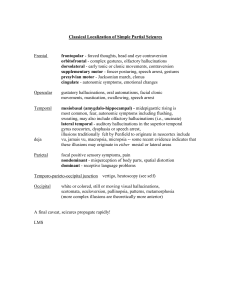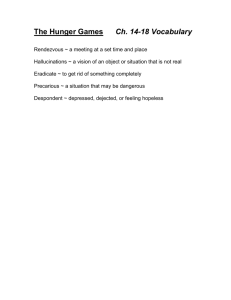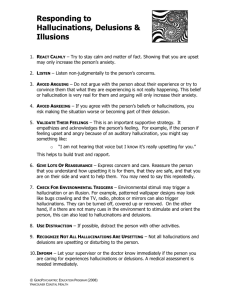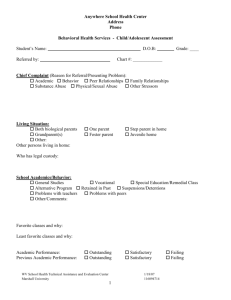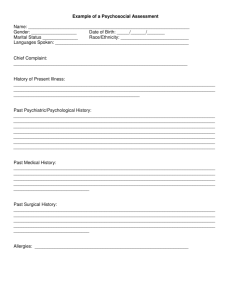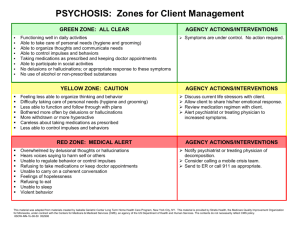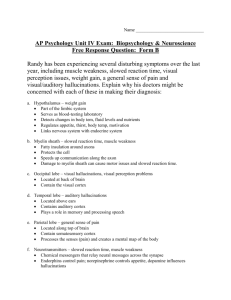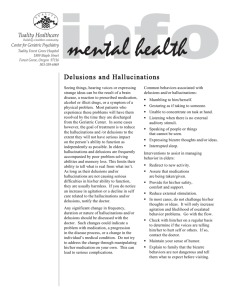Visual Hallucinations
advertisement
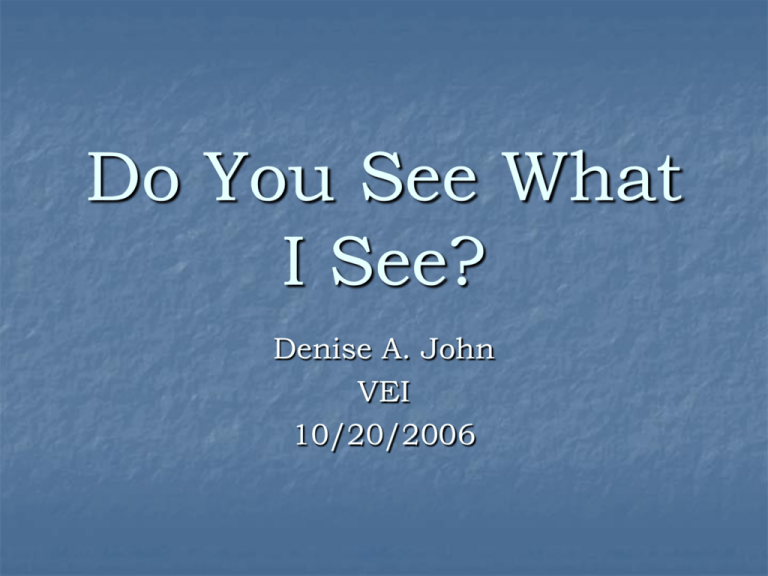
Do You See What I See? Denise A. John VEI 10/20/2006 Case HPI: 35 y/o ♀ c/o’s of “seeing shapes, colors & partially-formed images.” ROS: (+) Mild headache/weight loss/poor energy/constipation Questions??? Differential Diagnosis Classic Migraine Psychosis Psychiatric illness Schizophrenia Affective disorders Conversion disorders Metabolic/toxic Electrolyte imbalance Uremic Liver dz Infection Alcohol/drug effects Neurodegenerative disorder Diffuse Lewy Body Parkinson’s Alzheimer’s Sleep-related hallucinations “ Hypnopompic “ Peduncular hallucinations Seizures Release hallucinations Fortification Spectrum Case FHX: Glaucoma Heart & liver dz; HTN; cancer; stroke SHX: ø Tobacco/IVDA/ETOH NKDA MEDS: ASA; prednisone; pepcid; metoclopramide; anzemet; synthroid; colace; lexapro; zyprexa; morphine; lortab Case PMHX: Migraines Pituitary GH-producing adenoma Pituitary apoplexy Subarachnoid hemorrhage S/p trans-sphenoidal hypophysectomy x 2; CSF leak x 2 s/p repair Panhypopituitarism SIADH Depression Polycystic ovarian syndrome Psoriatic arthritis Case Alert & oriented x 3 Normal affect Pupils VA CVF: Unable OU 5 NR to light Partial reaction to near NLP 5 NLP Motility: Full OU IOP 11 12 External/PLE exam unremarkable DFE: Mild disc pallor OU Macula/vessels/periphery unremarkable OU Patient Patient Visual Hallucinations Visual Hallucinations Visual perceptions not associated with external visual stimuli Visual Hallucinations Simple (non-formed): Dots Colors Flashing lights Geometric patterns Visual Hallucinations Complex (formed): Objects Animals People Scenery Visual Illusions Distortion or modification of a real visual image Visual Hallucinations Most are NOT due to psychiatric dz Related to ocular, optic nerve or brain pathology Treatment involves managing underlying disorder Insight into the reality of the hallucinations varies with the associated etiology May interfere with daily functioning & cause significant anxiety Visual Hallucinations: Etiologies Phosphenes “Seeing light” Insight preserved Visual hallucinations: “Scintillating blue spots on a black background Rubbing closed eyes “Seeing stars” Sneeze, head trauma, low blood pressure “Flashes of light” (photopsias) Dim lightening or total darkness Light twinkles to bright flashes Irritation of photoreceptors Vitreous traction Retinal detachment/ inflammation Optic neuritis Esp. with EOM/sound Psychosis Visual Hallucinations: Complex Duration: Variable +/- Other hallucinations Esp. auditory +/- Insight preservation Release Hallucinations Complete or partial visual acuity/field loss from any cause Commonly seen in AMD Charles Bonnet Syndrome (CBS) Described in 1769 Swiss naturalist & philosopher ~ 14% prevalence in U.S. eye clinics with age Ø Gender predilection Release Hallucinations Theory of CBS: Sensory deprivation Visual cortex “release phenomenon” Input from other cortical areas (esp. memory) “fill-in” the sensory deficit Risk factors: Bilateral visual loss age Solitude Cognition Release Hallucinations Visual hallucinations: 65%: Weekly/monthly; 27%: Daily People: 80%; animals: 38%; plants/trees: 25%; buildings/other scenery: 15% Color: 63% Movement: 47% Duration: 53%: 1-60 mins; 13% < 5 secs Eyes open: 67% Teurisse et al. Visual hallucinations in psychologically normal patients: CBS. Lancet, 1996 Release Hallucinations Insight preserved Setting: Fatigue Stress Early mornings/late evening Poor lightening Often spontaneously resolve Worsening/improvement of visual loss Release Hallucinations Management: Reassurance of sanity Keep eyes closed Look away from visions Improve lightening social interactions Antipsychotic/antiepileptic medications Back to our patient… Assessment: Visual - deprivation hallucinations (Charles Bonnet Syndrome) Plan: Psychiatry consulted Olanzapine 5mg QHS References BCSC. Neuro-Ophthalmology. AAO. 2004-05 Kanski. Clinical Ophthalmology, 5th Ed. Butterworth Heinemann. 2003 Teurisse et al. Visual hallucinations in psychologically normal patients: CBS. Lancet, 1996 Manford et al. Complex visual hallucinations. Brain. 1998 Visual hallucinations caused by vision impairment. Geriatrics. 2002. 57 (6): 45-6 Charles Bonnet syndrome. Psychology of medicine. 1982;12: 251-61 Charles Bonner syndrome: A review. Journal of Mental Disorders. 1997; 185 (3): 195-200 Pelak et al. Visual Hallucinations. Current Science. 2006
